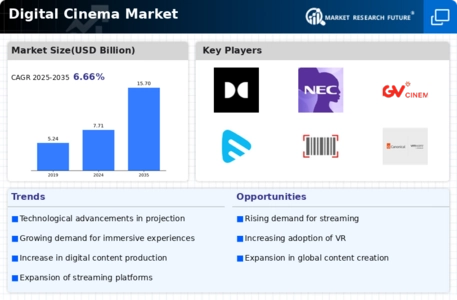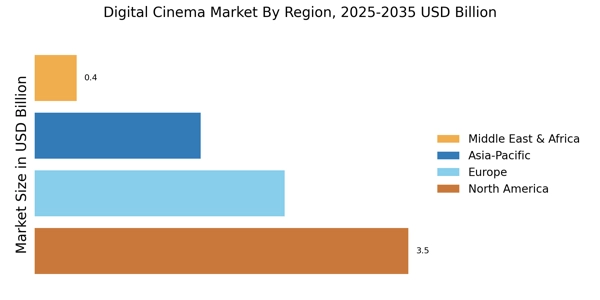The Digital Cinema Market has experienced significant growth due to the increasing adoption of digital technology in cinema exhibitions and enhanced consumer experiences through high-quality visual and audio output.
The competitive landscape is characterized by the presence of several key players focusing on innovative technologies, strategic partnerships, and expanding their global reach.
Players in this market are actively investing in research and development to offer cutting-edge solutions that cater to the demands of filmmakers and audiences alike. The dynamics of competition are further influenced by the ongoing shift towards home entertainment systems, prompting traditional cinema operators to embrace digital formats to stay relevant.
This evolution has created opportunities for advancements in projection, sound systems, and immersive experiences, intensifying the competitive environment.
Dolby Laboratories stands out in the Digital Cinema Market with its extensive portfolio of audio and imaging technologies that enhance the cinematic experience. The company's strengths lie in its reputed brand image, recognized globally for delivering superior sound quality and groundbreaking visual technologies, setting the standard within the industry.
Dolby's consistent innovation in digital cinema technology, such as Dolby Vision and Dolby Atmos, allows theaters to provide an immersive experience that captivates audiences, making it a preferred choice for filmmakers seeking to create visually stunning and audibly rich projects.
Dolby's strong partnerships with cinema operators and studios further solidify its market presence, ensuring that its technologies are widely integrated into digital cinema setups worldwide. This strategic positioning and commitment to high-quality performance give Dolby Laboratories a competitive edge in the rapidly evolving digital cinema landscape.
NEC Corporation also plays a pivotal role in the Digital Cinema Market, leveraging its technological expertise to deliver high-quality digital projection solutions. Recognized for its advanced digital projectors and robust display systems, NEC Corporation is committed to enhancing the movie-going experience with reliability and performance at the forefront.
The company excels in providing affordable solutions tailored to various cinema sizes and formats, allowing for wider adoption of digital cinema technologies across global markets. NEC's dedication to customer support and comprehensive service offerings adds further strength to its market position, as cinema operators often seek trustworthy partners for implementation and maintenance.
Additionally, NEC Corporation's focus on innovation ensures that it remains competitive in addressing emerging trends and demands within the digital cinema sector, positioning the company as a key player committed to shaping the future of cinema experiences.

















Leave a Comment